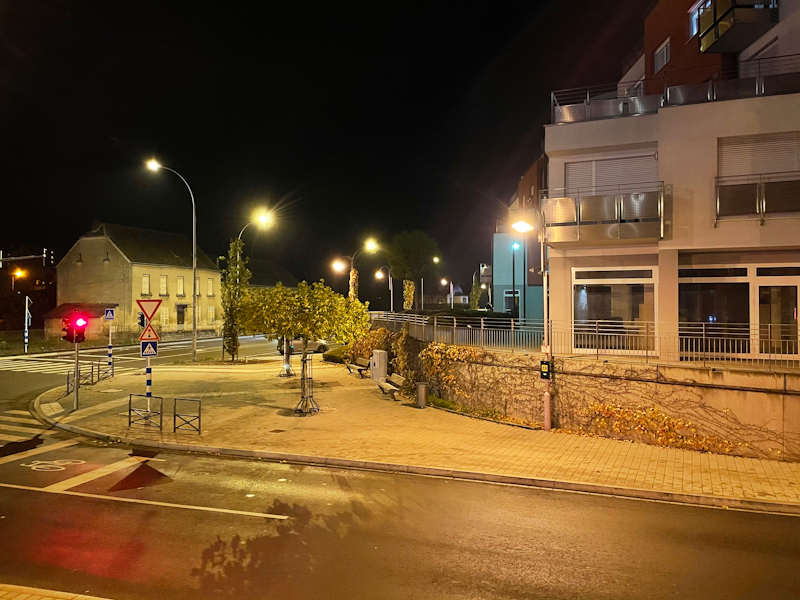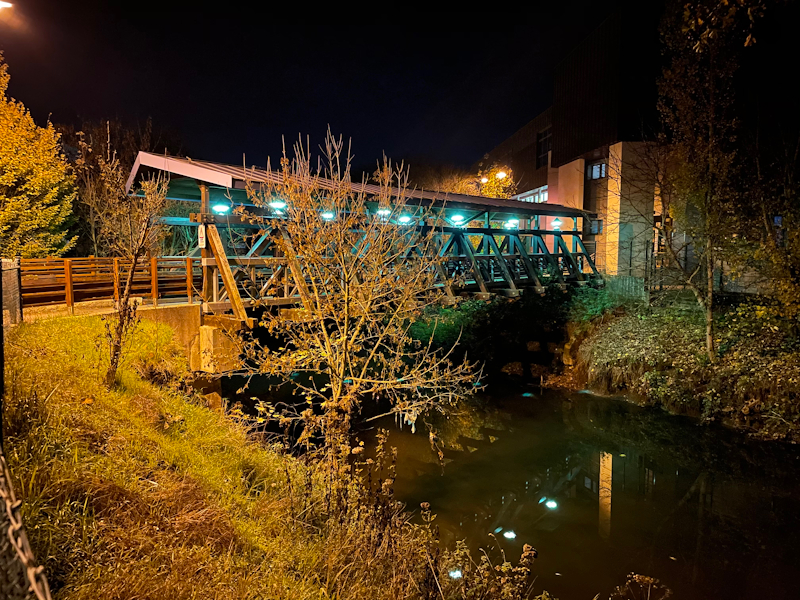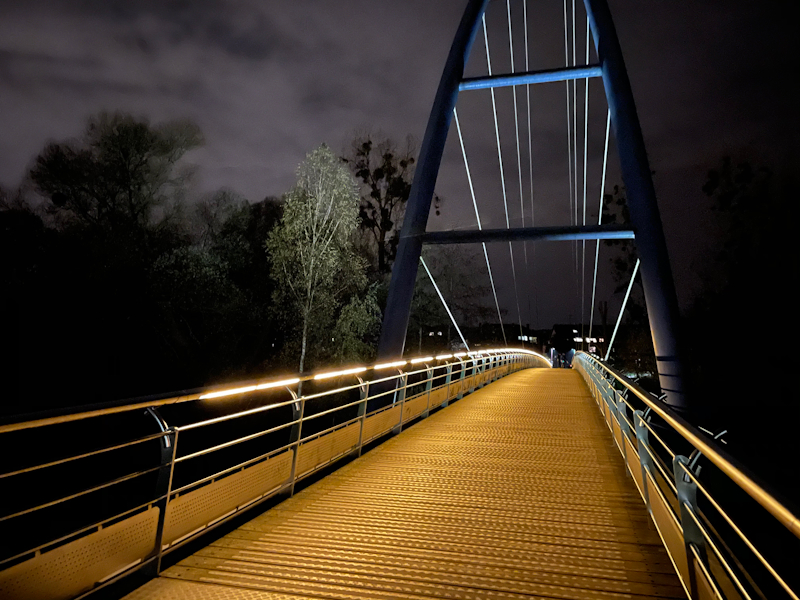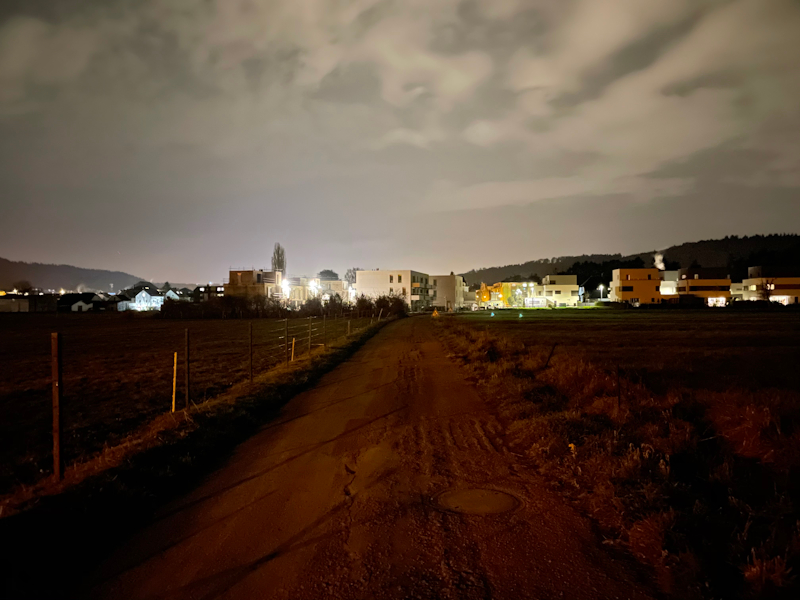The iPhone 12 & 12 Pro Review: New Design and Diminishing Returns
by Andrei Frumusanu on November 30, 2020 8:30 AM EST- Posted in
- Mobile
- Apple
- Smartphones
- Apple A14
- iPhone 12
- iPhone 12 Pro
Camera - Low Light Evaluation
Low-light capture on the iPhone 12’s should be improved for two reasons: First of all, the new f/1.6 lens of the main camera should allow for 27% better light capture compared to the f/1.8 unit of the iPhone 11’s. Secondly, Apple with this generation has finally addressed the lack of Night Mode on the ultra-wide and telephoto modules, resolving a quite huge handicap that was present on the iPhone 11 generation of devices.

[ iPhone 12 Pro ]
[ iPhone 11 Pro ]
[ Note20 Ultra (S) ]
[ S20+ (E) ]
[ Pixel 5 ] [ X-T30 ]
In this first scene, the results are actually a bit disappointing as we’re seeing almost no differences between the 12 Pro and the 11 Pro. The new phone uses half the exposure time according to the EXIF data, but has to use a higher ISO level to compensate. The only thing that’s noticeably better on the 12 Pro is the improved lens flare produced by the street light.
In general Apple’s Night Mode still doesn’t look to be as competitive as Google’s or Samsung’s implementation, as the S20, Note20 Ultra and the Pixel 5 perform quite better here.
On the ultra-wide angle, the inclusion of Night Mode now turns this camera module from something unusable to rather passable results. It’s a huge upgrade compared to the iPhone 11 series, but still lags behind the Pixel phone as far behind Samsung’s implementation.

[ iPhone 12 Pro ]
[ iPhone 11 Pro ]
[ Note20 Ultra (S) ]
[ S20+ (E) ]
[ Pixel 5 ] [ X-T30 ]
Night mode being fully automatically triggered on the iPhone’s camera, means there’s no way to force it on when there’s too much light, such as in this scene – which is really odd given that it did trigger on the iPhone 11 Pro, thus producing an overall better result than the 12 Pro.
The UWA again gains massive usability with the addition of Night Mode, although all the phones here produce quite bad results for a variety of different reasons.

[ iPhone 12 Pro ]
[ iPhone 11 Pro ]
[ Note20 Ultra (S) ]
[ S20+ (E) ]
[ Pixel 5 ] [ X-T30 ]
Here, the 12 Pro uses the larger aperture optics to reduce the ISO from 800 to 640. There’s a slight change in colours, but overall I wouldn’t say that it’s something that would be immediately noticeable between the two generation of phones.

[ iPhone 12 Pro ]
[ iPhone 11 Pro ]
[ Note20 Ultra (S) ]
[ S20+ (E) ]
[ Pixel 5 ] [ X-T30 ]
This scene was a bit odd for the two iPhones as they both showcased identical exposure times as well as ISO levels, although the iPhone 12 Pro shot is brighter due to the larger aperture. The phone didn’t trigger Night Mode for this shot as it was too bright.
Night Mode for the UWA is a large jump for the iPhone 12, but it can’t compete against the Samsung devices or the Pixel phone, although the latter got the colour temperature completely wrong.

[ iPhone 12 Pro ] [ iPhone 11 Pro ]
[ Note20 Ultra (S) ] [ S20+ (E) ]
[ Pixel 5 ] [ X-T30 ]
Here again the iPhone 12 Pro uses the larger aperture in order to reduce the ISO levels of the shot, which is a bit odd given that I feel that the iPhone 11 Pro had the sharper and less noisy shot. There’s also a change in colour temperature although saying which is better is subjective.

[ iPhone 12 Pro ] [ iPhone 11 Pro ]
[ Note20 Ultra (S) ] [ S20+ (E) ]
[ Pixel 5 ] [ X-T30 ]
Finally, in an extreme low-light shot I’m simply challenging the light capture abilities of the cameras here. This scene was extremely dark and the first sample shot of the Fuji is likely better representation of the scene as experienced in-person, while the EV+2 shot is closer to the exposure the phones are trying to achieve.
Neither of the phones are faring well here, and the iPhone 12 Pro does change a bit of the tone-mapping compared to the iPhone 11 Pro, faring a bit better, although I feel the Samsung phones are producing a more natural look.
Low-Light Conclusion: Improved, but not Competitive
In general, I feel that Apple may have overpromised a bit on the part of the low-light capture ability of these new phones. While we do notice the larger aperture optics of the new modules in the resulting captures, Apple doesn’t seem to have substantially changed their Night Mode processing this year as sometimes it’s very hard to distinguish the iPhone 12 from the iPhone 11 results.
On the ultra-wide angle, the new Night Mode options obviously transforms previously unusable results into something that’s more passable. I feel that this shouldn’t be taken as praise versus Apple finally addressing a huge feature lack in the iPhone 11 series, as they were the only devices on the market actually lacking this functionality on the ultra-wide modules.
Although the results have improved, Apple here still largely lags behind the competition which sports better hardware, and also has been able to iterate on their computational photography modes over the past year.
It’s a pity that Apple chose to only employ a larger improved camera sensor on the iPhone 12 Pro Max, creating model differentiation on the cameras that previously didn’t exist – I would have had at least wished the 12 Pro to also house this improved sensor, if possible.










101 Comments
View All Comments
caribbeanblue - Friday, December 18, 2020 - link
The 2GB extra RAM on the Pro models have shown in a lot of comparison videos I’ve watched on Youtube that they keep more apps open in the background than a standard Android phone with 12GB RAM. But I hope next year we’ll see 6GB in the normal and 8GB RAM in the Pro models, because I have problems keeping apps open in the background with the 4GB RAM in my 11 Pro Max as well.Samus - Wednesday, December 2, 2020 - link
I mean, it’s going in a case anyway, the edges and texture of a phone mean nothing if it’s in a case. Which frankly it should be these are like $1000 investments and everybody eventually drops their phone at some point. I’ve been lucky enough to have never broken one, probably because it’s always in a case and I’m not clumsy enough for it to fall on its screen.crotach - Friday, December 4, 2020 - link
I'm a tall person with massive hands and I prefer flat edged phones :)cha0z_ - Monday, November 30, 2020 - link
The key part here is "mini" - that form factor is totally ok for small phones, but hold the 12 pro max and you can clearly tell it's a lot less comfortable vs the 11 pro max.austinsguitar - Monday, November 30, 2020 - link
the edges are great at the regular and small sizes. just not okay for the huge phones your 4 foot tall girl friend has. you know.rrinker - Monday, November 30, 2020 - link
I've always preferred the square edges older models to the rounder newer ones myself. Seemed like I had better grip and the phone wasn't about to slip out of my hand.RaLX - Monday, November 30, 2020 - link
Exactly, I love the 12 edge, in fact I just went back to iPhones after years using Pixel and Nexus phones partly because I love the "new" old design of flat edges.Devo2007 - Tuesday, December 1, 2020 - link
That’s how I feel about my 12 Pro Max as well. Yes, it’s big, but the flat edges actually provide a better grip for me. I would actually feel comfortable not using a case at least at home with this phone, which I definitely wouldn’t say about the iPhone 11 Pro Max.cha0z_ - Tuesday, December 1, 2020 - link
I am using 11 pro max from over a year naked, never dropped it or had a feeling I don't have a good grip.Cellar Door - Tuesday, December 1, 2020 - link
That is a bit irrelevant - since basically no one uses high end phone with no case these days, unless you get a 10pack of them and don't care if you break one, once a month.